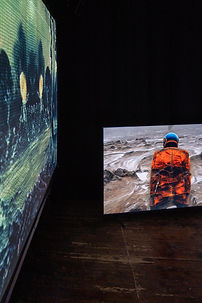





"Collateral Landscapes". (2025)
Video installation. HD. One central projection, four lateral screens.
Ambisonics Audio 3rd Order (adapted to quadraphonics layout).
16.33 minutes.
Collateral Landscapes is an immersive installation that explores the symbolic, discursive, and visual correspondences between emotional collapse and war-torn environments. The project proposes a critical parallel between the language of emotional rupture and that of military conflict—wound, defeat, betrayal, ruins, scars, border, pain, inmolation, etc.—revealing how inherited narratives of love often reproduce structural logics of loss and confrontation.
Using ambisonic audio technology, field recordings, and digitally manipulated imagery, the work constructs a multisensory environment that resists linear storytelling. Instead, it offers an experiential space grounded in perceptual disorientation, poetic resonance, and spatialized sound as a vehicle for emotional navigation. This is not a story to be told, but a landscape to be inhabited—not a resolution, but a movement through ruins.
Collateral Landscapes traces the symbolic remnants of romantic experience not as personal failure, but as the emotional consequence of inherited, idealized structures of love. By placing this experience within a digital and sonic environment marked by fragmentation, echo, and interference, the work also offers a critique of the hostile affective conditions that shape contemporary emotional life—conditions that are both personal and systemic.
The immersive dimension of the work is not only formal, but conceptual: the audience is invited to enter an emotional geography shaped by loss, solitude, and the slow reconstruction of meaning. Through this aesthetic transposition, the work positions grief—romantic and symbolic—as an expanded field where the affective and the political intersect.
This project was funded by the Arts Council of Northern Ireland and developed with the support of DAS XR Lab, and SARC: Centre for Interdisciplinary Research in Sound and Music, Queen’s University Belfast.
Technical details:
The installation consists of a large-scale projection accompanied by four smaller screens distributed in the exhibition space. The sound design was composed in a 16-channel ambisonic format and adapted into quadraphonic playback for the exhibition. Visual material was created through digital image manipulation, visual coding, and the integration of generative poetic fragments woven into the audiovisual fabric of the piece.
Photo credit: Catherine Devlin